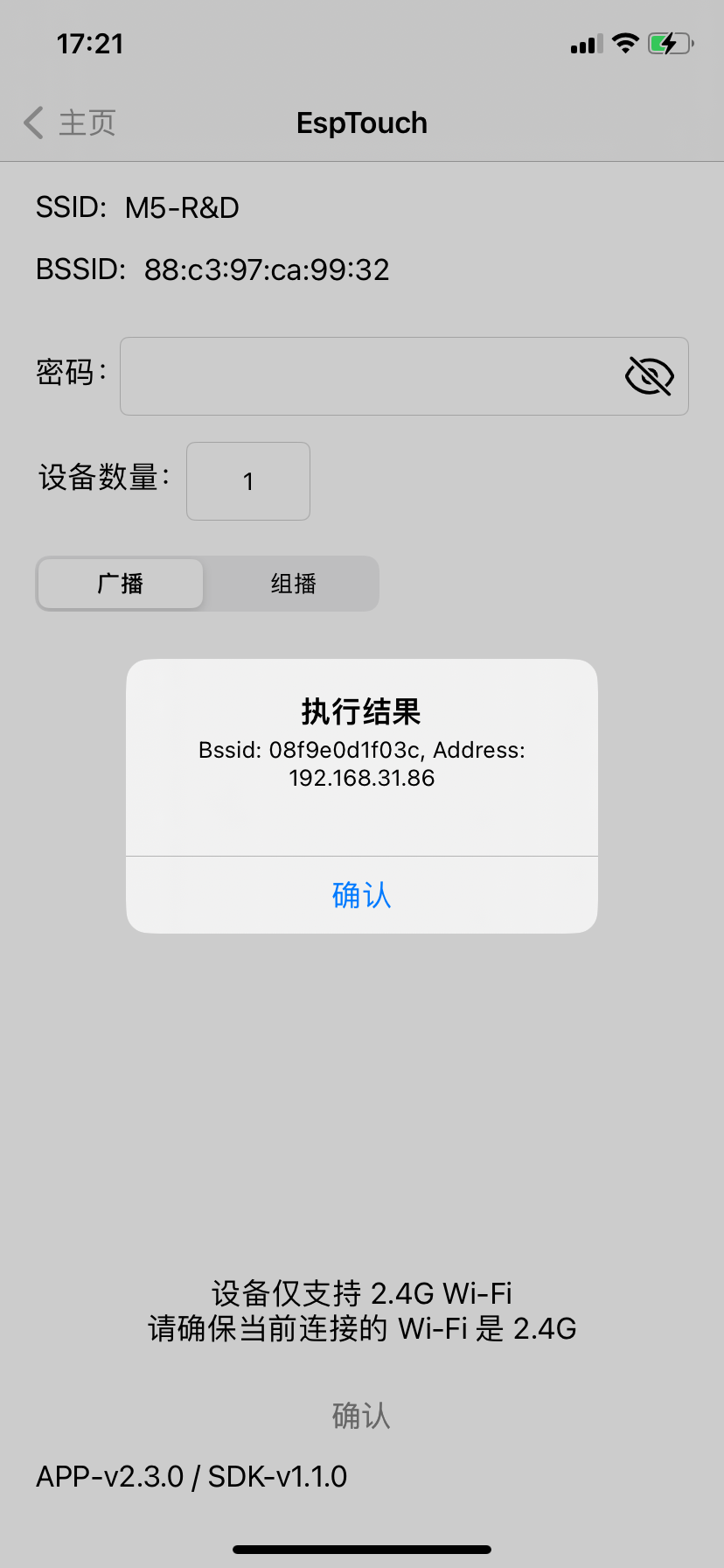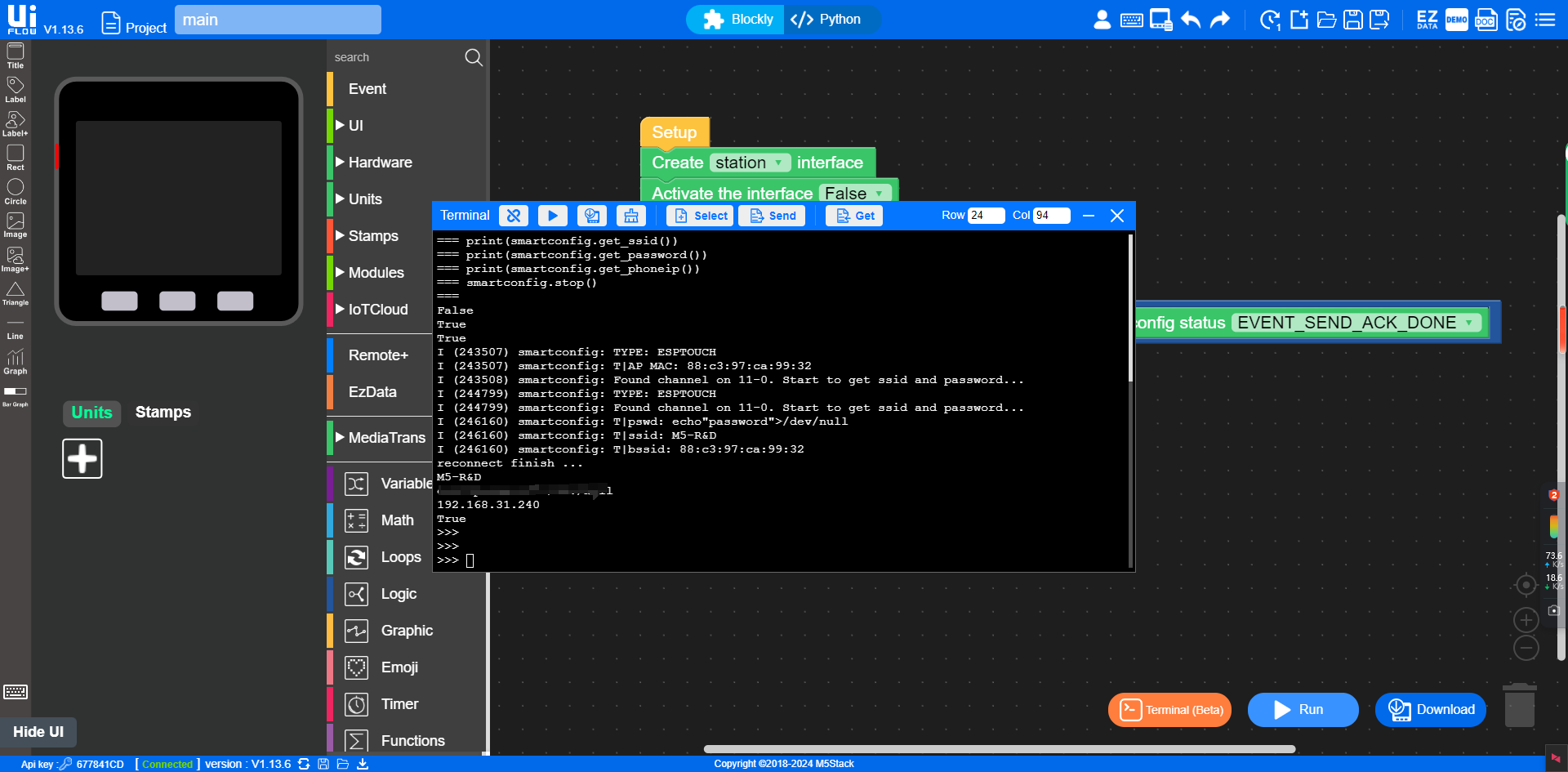Network
Example
Example 1
Set the Wi-Fi name and password, connect to Wi-Fi, and print the connection result to the serial monitor.

from m5stack import *
from m5stack_ui import *
from uiflow import *
import wifiCfg
wifiCfg.doConnect('M5-R&D', '**********')
print(wifiCfg.wlan_sta.isconnected())
Example 2
Download the Esptouch app on your phone, upload the program to the M5 device, and enter the Wi-Fi password in the Esptouch app. If the serial monitor shows a successful connection and displays the IP address, the device has successfully connected to Wi-Fi and will automatically connect to this Wi-Fi in the future.

- After uploading the program to the M5 device, enter the Wi-Fi password in the Esptouch app and click confirm.

- After completion, the device automatically connects to Wi-Fi and outputs the IP address.

API

wifiCfg.autoConnect(lcdShow=False)
- Attempts to automatically connect to a previously configured Wi-Fi network.

wifiCfg.autoConnect(lcdShow=True)
- Attempts to automatically connect to a previously configured Wi-Fi network and displays the connection status on the LCD.

wifiCfg.reconnect()
- Attempts to reconnect to a previously configured and saved Wi-Fi network. This method is typically used to retry a connection after the device loses connection.

wifiCfg.doConnect('', '')
- Sets the Wi-Fi name (SSID) and password.

M5Label('label0', x=193, y=67, color=0x000, font=FONT_MONT_14, parent=None)
- Represents sending a point-to-point message to a specified API Key.

str(getP2PData())
- Retrieves received P2P (point-to-point) message data.

network.WLAN(network.STA_IF)
- Creates a WLAN (Wireless Local Area Network) interface object. Choose the Wi-Fi mode:
- Station mode: Connect to a local area Wi-Fi network.
- Access point mode: Create your own Wi-Fi hotspot.

wlan.config(essid='', password='', authmode=network.AUTH_OPEN)
- Configures the WLAN interface parameters.
essid: Sets the access point's SSID (network name).password: Sets the access point's password.authmode: Sets the access point's authentication mode.

wlan.active(True)
- Activates the interface: This command is used to enable the device's Wi-Fi functionality, allowing it to begin wireless communication.

str(wlan.scan())
- Scans for nearby Wi-Fi networks and returns a list containing available network information.

str(wlan.isconnected())
- Checks if the ESP32 is connected to a Wi-Fi network.

wlan.connect('your_SSID', 'your_PASSWORD')
ssid: The name of the Wi-Fi network to connect to.password: The password for the Wi-Fi network.

str(wlan.config('mac'))
- Retrieves the device's MAC address and converts it to a string format.
- Retrieves the currently configured SSID (network name) and converts it to a string format.

str(wlan.ifconfig())
- Retrieves the device's network configuration.

str(wlan.status())
- Retrieves the current Wi-Fi connection status.

wlan.disconnect()
- Disconnects from the Wi-Fi network.

str(1001)
STAT_IDLE: Wi-Fi idle status. The device is not currently attempting to connect to any Wi-Fi network.STAT_CONNECTING: Wi-Fi connecting status. The device is attempting to connect to the specified Wi-Fi network.STAT_GOT_IP: Wi-Fi connected and obtained an IP address. The device has successfully connected to the Wi-Fi network and received an IP address from the DHCP server.

smartconfig.set_type(smartconfig.ESPTOUCH)
ESPTOUCH: Uses the ESPTOUCH protocol for configuration. The Wi-Fi configuration information (SSID and password) is sent to the device via a mobile app, allowing it to connect to the specified Wi-Fi network.AIRKISS: Uses the AIRKISS protocol for configuration. AIRKISS is a wireless configuration protocol developed by Tencent, used to send Wi-Fi configuration information to the device.ESPTOUCH_AIRKISS: Uses both ESPTOUCH and AIRKISS protocols simultaneously for configuration. The device will listen to both protocols, and the mobile app can use either protocol to send Wi-Fi configuration information. The device will configure itself after receiving the information.

smartconfig.start()
- Starts the SmartConfig feature, putting the device into SmartConfig configuration mode, and waits to receive Wi-Fi configuration information (SSID and password) from the mobile app.

smartconfig.stop()
- Stops the SmartConfig feature and exits SmartConfig configuration mode.

str(smartconfig.status())
- Retrieves the current status of SmartConfig.

str(smartconfig.get_ssid())
- Retrieves the SSID (network name) received during the SmartConfig process.

str(smartconfig.get_password())
- Retrieves the password received during the SmartConfig process.

str(smartconfig.get_phoneip())
- Retrieves the phone's IP address during the SmartConfig process.

str(smartconfig.get_phoneip())
- Represents the event when SmartConfig completes scanning for Wi-Fi networks.
